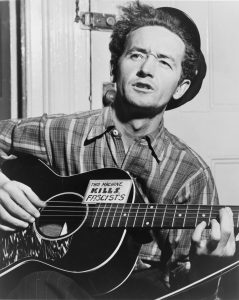
Since there has always been social injustice in the world, there have always been people protesting many social ills. In many instances, people express oppression through chants and songs.
Notable examples include Beethoven’s “Ode to Joy” (based on the Friedrich Schiller poem “Ode to Freedom”), which supported universal brotherhood and was in opposition to the slavery that existed in many parts of the world. Back in 1795, citizens protested women’s rights by singing a feminist protest tune “Rights of Woman”, which was a reworking of “God Save The Queen.”
During the 20th century, folk and blues artists started to raise their voices to shed a light on social injustices. Notable artists included Joe Hill, Lead Belly, and Josh White. Billie Holiday’s 1939 anti-lynching tune, “Strange Fruit” is widely regarded as an important catalyst for the civil rights movement.
Folk artists like the Almanac Singers and Woody Guthrie (armed with his weapon of choice, a guitar which bore the sticker, “This Machine Kills Fascists”) contributed greatly to the canon of protest anthems. Guthrie greatly influenced Bob Dylan and numerous other socially conscious musical artists.
Even though the 60s are often called the golden age of protest music, protest music continues to evolve throughout the years. In the 70s soul music started to overtake folk as the voice of social consciousness. Punk also started to emerge as the voice of disenfranchised youth. In the 80s/90s there was the development of the hardcore scene and socially conscious rap music. The 2000s saw several protest tunes about President Bush and the Iraq War (which was that decade’s Nixon and Vietnam). In recent times, Donald Trump being elected President of the USA ushered in a new era of protest.
This website focuses on the ongoing development of protest songs. The founder of this site and chief contributor CJ Baker is a published writer and life long music fan. Growing up as a socially awkward kid with a speech impediment and learning disability, music has always provided him with an emotional outlet to deal with his personal angst. As he got older he started to become interested in the historical developments of music. This included being drawn to music with a socially conscious message. Along with this website, he also started the companion podcast, Ongoing History of Protest Music.